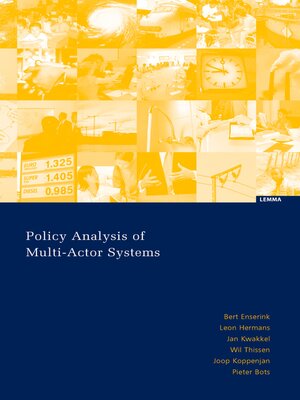
Sign up to save your library
With an OverDrive account, you can save your favorite libraries for at-a-glance information about availability. Find out more about OverDrive accounts.
Find this title in Libby, the library reading app by OverDrive.



Search for a digital library with this title
Title found at these libraries:
| Library Name | Distance |
|---|---|
| Loading... |
Policy analysts love solving complex problems. Their favorite problems are not just technically complex but also characterized by the presence of many different social actors that hold conflicting interests, objectives, and perceptions and act strategically to get the best out of a problem situation. This book offers guidance for policy analysts who want to assess if and how their analysis could be of help, based on the premise that problem formulation is the cornerstone in addressing complex problems. This book positions policy analysis within the theories on processes of policy making, and focuses on methods and techniques for structuring complex problems. The book takes a systems perspective as its basis, complemented by techniques for analyzing multi-actor systems, and for dealing with an uncertain future. Analytical results are then interpreted and used for problem formulation. In the last part of the book, the resulting problem formulation is used to diagnose meaningful follow-up activities, including potential in-depth policy analysis research. This book is firmly embedded in problem structuring theory, but also shows the tricks of the trade, the assumptions underlying practice, the choices that need to be made, and the dilemmas encountered by the analyst. The authors are involved in teaching problem structuring methods and policy analysis at the Faculty of Technology, Policy and Management of Delft University of Technology. Their interdisciplinary approach to problem formulation reflects their multi-disciplinary backgrounds, which range from physics, informatics and land-use planning to public administration and the philosophy of technology. Introduction to Policy Analysis of Multi- Actor Systems 11 1 Introduction 13 1.1 The Challenge of Policy Analysis in Multi-Actor Systems 13 1.2 The Problem Formulation Focus 14 1.2.1 Problem Formulation in Problem Solving 15 1.2.2 Policy Problems: Gaps and Dilemmas 16 1.3 Policy Analysis as a Contribution to Problem Solving 18 1.3.1 Analytical Activities 18 1.3.2 Analytical Styles 20 1.3.3 The Role of the Analyst 21 1.3.4 Positioning This Course Book 22 1.4 Reading Guide 23 References 24 2 Problem Formulation in Complex Environments 25 2.1 Coping with Complexity 25 2.1.1 Technical Dimension of Problems 27 2.1.2 Social Dimension of Problems 28 2.2 Framing Complexity 31 2.2.1 Structured and Unstructured Problems 32 2.2.2 Objective versus Subjective Problems: The Role of Perceptions and Interests 34 2.2.3 The Problem Formulation Battle 36 2.2.4 The Social Construction of Problems 37 2.3 Problem Formulation as Part of a Policy Process 38 2.3.1 Garbage Cans 38 2.3.2 Problem Solving Following the Streams Model 40 2.3.3 Problem Solving in Arenas and Rounds 41 2.3.4 Problem Solving and Advocacy Coalitions 42 2.4 Stepping Stones to Solutions 43 2.5 Problem Formulation as First Step in Policy Analysis 45 References 49 3 Systems Analysis 51 3.1 Introduction to Systems Analysis 51 3.2 Conceptual Framework for Systems Analysis 52 3.2.1 The System Diagram and Its Contents 52 3.2.2 A Note on Terminology 54 3.3 A Method for an Exploratory Systems Analysis 57 3.3.1 Step 1: Problem Demarcation 58 3.3.2 Step 2: Specify Objectives and Criteria 63 3.3.3 Step 3: Identify Means and Map Causal Relations 69 3.3.4 Step 4: Overview of the System and Its Boundaries 73 References 77 4 Actor Analysis 79 4.1 Introduction: Why Actor Analysis? 79 4.2 Conceptual Framework for Actor Analysis 80 4.3 Methods for Actor Analysis 81 4.4 Steps in Actor Analyses 83 4.4.1 Step 1: Use Problem Formulation as Point of Departure 83 4.4.2 Step 2: Make an Inventory of the Actors Involved 85 4.4.3 Step 3: Mapping Formal Relations 89 4.4.4 Step 4: Drafting Problem Formulations of...







